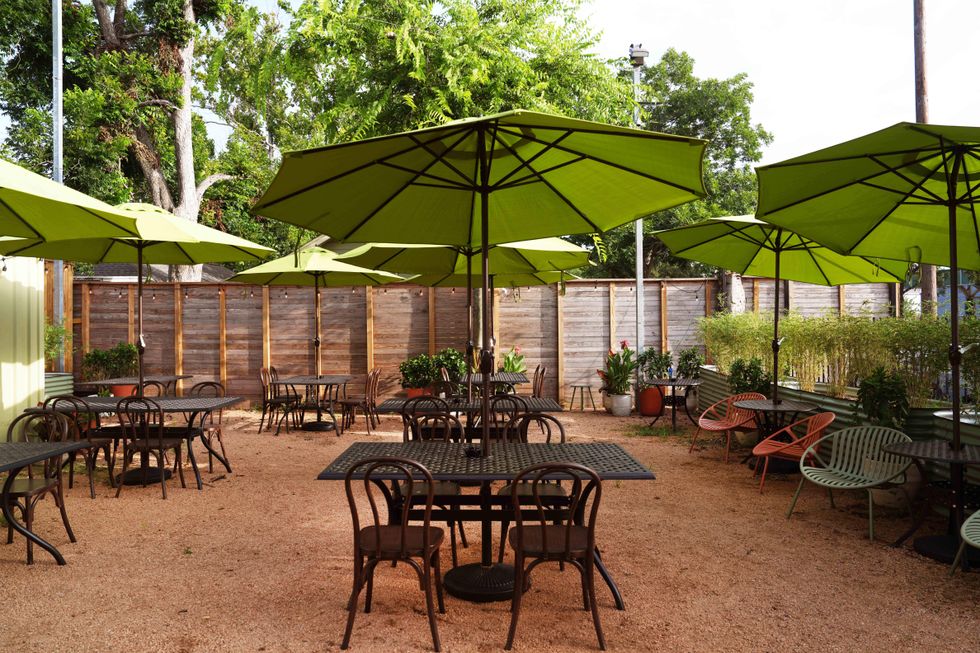Cliff notes
With The Country Cooking of Greece, Diane Kochilas offers recipes for simple,healthy meals
 Diane KochilasPhoto by © Yiorgos Vitsaras
Diane KochilasPhoto by © Yiorgos Vitsaras Shrimp saganakiPhoto courtesy of Yia Yia Mary's
Shrimp saganakiPhoto courtesy of Yia Yia Mary's Cheese and herb frittersPhoto courtesy of Yia Yia Mary's
Cheese and herb frittersPhoto courtesy of Yia Yia Mary's The Country Cooking of Greece features an eggplant, quince and sweet potato stewon the cover.
The Country Cooking of Greece features an eggplant, quince and sweet potato stewon the cover. Diane Kochilas, left, and Georgea PappasCourtesy Photo
Diane Kochilas, left, and Georgea PappasCourtesy Photo Meze spreadPhoto by © 2010 Vassilis Stenos
Meze spreadPhoto by © 2010 Vassilis Stenos Dakos salad with tangerine juicePhoto by © 2010 Vassilis Stenos
Dakos salad with tangerine juicePhoto by © 2010 Vassilis Stenos Borlotti beans with caramelized whole onions and cuminPhoto by © 2010 Vassilis Stenos
Borlotti beans with caramelized whole onions and cuminPhoto by © 2010 Vassilis Stenos
Times are tough in Greece, but that hasn't stopped families and friends from gathering around the table for great food and lively conversation.
"Even in these dire circumstances, they still have to eat, and so does everyone else," says Diane Kochilas, the noted cookbook author who splits her time between Athens, the Greek island of Ikaria and New York. "Greek food has been totally unsullied by anything that has been going on in Greece, thank god for that."
For the past four years, Kochilas has been scouring villages throughout Greece for the best in country cooking. The result is her latest book, The Country Cooking of Greece (Chronicle Books, $50), with 250 recipes from every corner of the small Mediterranean nation.
Recipes range from artichoke flan from the island of Tinos to northern Greek-style braised leeks and celery root with paprika and lemon; from octopus cooked with leeks and sun-dried tomatoes from the seaside towns on the fringes of Macedonia to cheese, potato and zucchini pie from Hania in western Crete.
"Greek food has been totally unsullied by anything that has been going on in Greece, thank god for that."
Kochilas, who has written 18 books on Greek cuisine and is a consultant to popular Greek restaurants Boukiés and Pylos in New York, notes that the cuisine is perfect for our times because it is healthy and simple.
"It's an easy export. The products are very good. They're very healthy. Greek cooks have known that for centuries," she says.
To prove her point, Kochilas recently taught the staff at Yia Yia Mary's how to whip up some appetizers from her new book for the restaurant's patrons. Two summers ago, Pappas Restaurants culinary research and development director Georgea Pappas and her cousin, Eleni, attended a culinary school in Ikaria taught by Kochilas, where they struck up a friendship. The duo have been working to get Kochilas to Houston ever since.
During her Houston trip, Kochilas also attended the Greek Festival, taught a cooking class at Central Market and went shopping for cowboy boots at Cavender's.
Among the mouth-watering appetizers I sampled were a fire-roasted eggplant salad dip with walnuts, a spicy Greek cheese dip with lemon and hot chiles, and a parsley salad with red onions, capers and ciabatta bread crumbs.
"Greece is a small country but has well-entrenched traditions. There's a lot of different food," Kochilas explains. "The roasted eggplant is a dish you find in all parts of Greece, but in different variations. This is a northern Greece rendering of that dish with walnuts and garlic and a little vinegar. In the Aegean, where capers are one of the staples you would find the same idea. I've seen it with roasted peppers and feta cheese."
"Greeks have been so successful in the restaurant industry because we have hospitality in our DNA. It's true. You cannot go anywhere without people offering you something to eat."
Kochilas notes that that one dip can be made in an "amazing" variety of ways. "We could have prepared 20 different kinds," she says. "There is a full palate of flavors waiting to be exposed in the United States."
Among the mezes (or small plates) Kochilas and the staff at Yia Yia Mary's prepared were lightly deep fried cheese and herb fritters, known as kefedtes, beef meatballs flavored with cumin and other spices and braised in red wine tomato sauce, and a head-on shrimp saganaki with tomato, onion, garlic and ouzo.
While most Americans think of saganki as a flamed cheese dish, Kochilas says that anything cooked in a saganaki pan (a small, shallow two-handled skillet) is referred to by that name.
Her latest book, which is part of a series by different authors examining country cooking in various nations, steers away from the traditional Greek dishes of roasted lamb, potatoes and a olive-and-feta salad to simpler, yet more adventuresome fare. "For me, this book is actually about breaking the stereotypes," she said.
The cover photo features a dish made of eggplant, sweet potatoes and quince from the Ionian area in western Greece. "It's a farmer's dish — an end of summer, beginning of fall dish. I see many dishes like this. Greek food is still by and large seasonal," she says.










